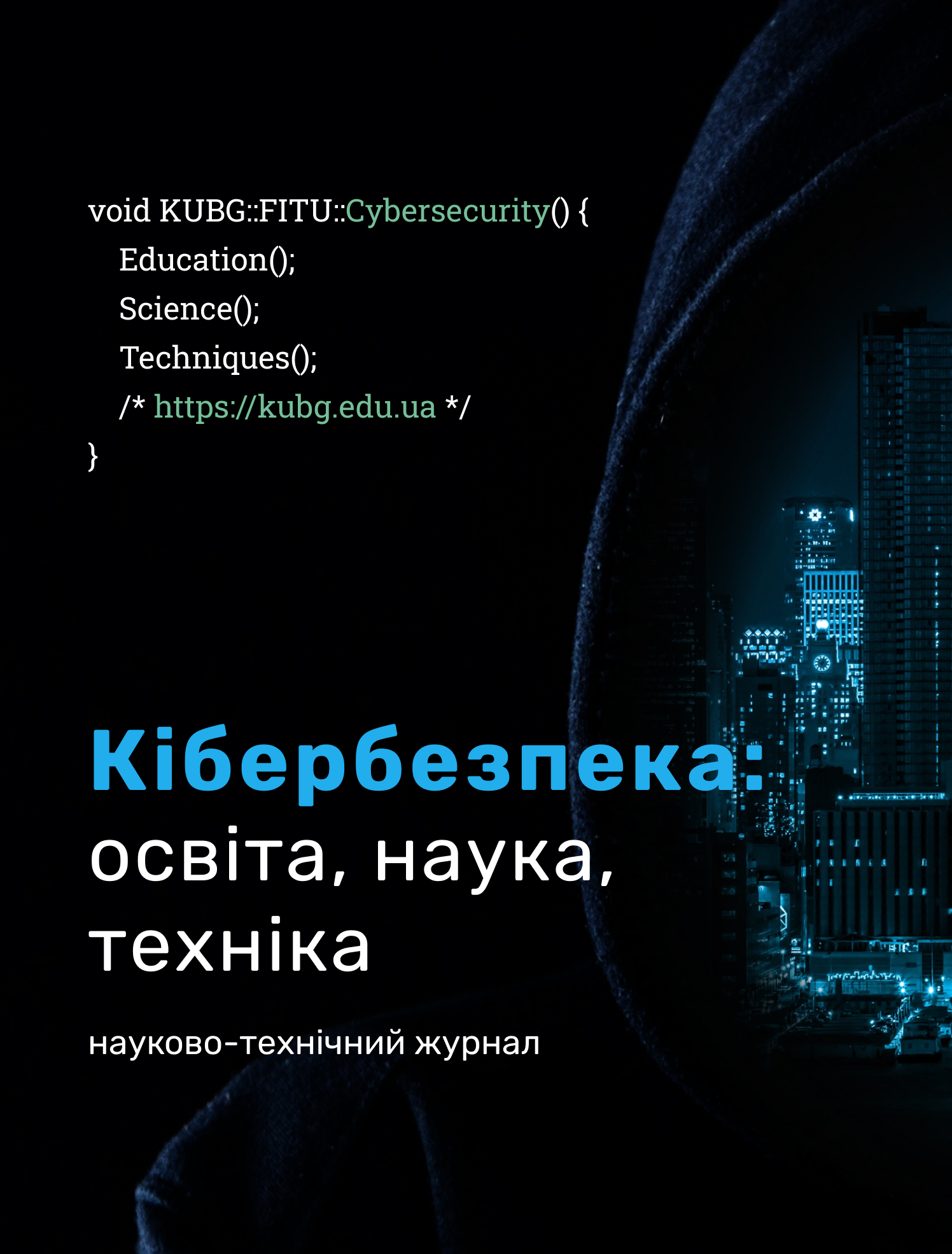INTEGRATION OF IOT AND ARTIFICIAL INTELLIGENCE INTO INTELLIGENT TRANSPORTATION SYSTEMS
DOI:
https://doi.org/10.28925/2663-4023.2024.26.708Keywords:
Internet of Things, IoT, sensors, detectors, network, intelligent transportation system, smart city, AI, security, energy resources, anomalies, reliability, nodesAbstract
The article provides a detailed analysis of the conceptual and practical features of integrating Intelligent Transportation Systems (ITS) into urban environments, with a focus on the use of Internet of Things (IoT), Artificial Intelligence (AI), and edge computing technologies. A conceptual model of ITS has been developed, enabling not only real-time collection and processing of sensor data but also dynamic decision-making based on big data analytics. The multi-level architecture of ITS is examined, employing modern optimization, prediction, and clustering algorithms to enhance traffic management adaptability, minimize congestion, and reduce CO₂ emissions. Examples of successful ITS implementations in leading global cities are presented, showcasing their positive impact on increasing traffic throughput, reducing accident rates, and improving environmental conditions. Particular attention is paid to cybersecurity issues, which are critical for the stable and reliable operation of ITS. Potential threats associated with unauthorized access to system resources are analyzed, and the implementation of advanced encryption mechanisms, multi-factor authentication, and blockchain technologies is proposed to ensure data integrity and confidentiality. The article also highlights the development of effective anomaly detection algorithms capable of promptly responding to non-standard situations, such as traffic accidents or sudden changes in traffic flows. This ensures system resilience and flexibility in dynamic urban environments. The prospects for further ITS development through deeper integration of edge computing, Big Data technologies, and AI are emphasized, contributing to enhanced overall efficiency, safety, and adaptability of urban transportation infrastructure. The proposed ITS model incorporates energy efficiency, enables highly accurate traffic flow prediction, and ensures environmental sustainability in urbanized spaces. Practical recommendations for implementing the developed ITS are provided, emphasizing its ability to evolve and adapt to changes in traffic intensity, infrastructural constraints, and environmental safety requirements.
Downloads
References
hang, K. & Batterman, S. (2013). Air pollution and health risks due to vehicle traffic. Sci. Total Environ., 450–451, 307–316. https://doi.org/10.1016/j.scitotenv.2013.01.074
Nguyen, H., Nguyen, P., & Bui, V. (2022). Applications of Big Data Analytics in Traffic Management in Intelligent Transportation Systems. JOIV: International Journal on Informatics Visualization, 6, 177. https://doi.org/10.30630/joiv.6.1-2.882
Tran, D.-K, Hoang Dinh, Q., Le, V.-T., Thai, M.-D., & Do, T.-H. (2022). Real-Time Traffic Flow Prediction Using Big Data Analytics. Intelligence of Things: Technologies and Applications . ICIT 2022. Lecture Notes on Data Engineering and Communications Technologies, 148. https://doi.org/10.1007/978-3-031-15063-0_38
Dmitrieva, E., Pathani, A., Pushkarna, G., Acharya, P., Rana, M., & Surekha, P. (2024). Real-Time Traffic Management in Smart Cities: Insights from the Traffic Management Simulation and Impact Analysis. BIO Web of Conferences, 86. https://doi.org/10.1051/bioconf/20248601098
Zanella, A., Bui, N., Castellani, A., Vangelista, L., & Zorzi, M. (2014). Internet of Things for Smart Cities. IEEE Internet of Things Journal, 1(1), 22–32. https://doi.org/10.1109/JIOT.2014.2306328
Bibri, S. E. (2018). Smart sustainable cities of the future. Springer.
INRIX Global Traffic Scorecard. (2023). INRIX Research. https://inrix.com/scorecard
Ambient (outdoor) air quality and health. Fact sheet. (2024). World Health Organization. https://www.who.int/news-room/fact-sheets/detail/ambient-(outdoor)-air-quality-and-health
Bibri, S., & Krogstie, J. (2017). Smart Sustainable Cities of the Future: An Extensive Interdisciplinary Literature Review. Sustainable Cities and Society, 31. https://doi.org/10.1016/j.scs.2017.02.016
GrowSmarter. (2024). https://grow-smarter.eu/home/
Amsterdam Smart City. (2024). https://amsterdamsmartcity.com/
Smart Nation Singapore. (2024). https://www.smartnation.gov.sg/
Smart Dubai. (2024). https://www.smartdubai.ae/
MK:Smart. (2024). https://www.mksmart.org/
Smart Kalasatama. (2024). https://fiksukalasatama.fi/en/
Tokyo Smart City. (2024). Tokyo Metropolitan Government. https://www.metro.tokyo.lg.jp/
Cervero, R. (2014). Transport Infrastructure and the Environment in the Global South: Sustainable Mobility and Urbanism. Jurnal Perencanaan Wilayah dan Kota, 25, 174–191. https://doi.org/10.5614/jpwk.2015.25.3.1
Ferrández-Pastor, F. J., et al. (2018). Developing ubiquitous smart cities sensor network platform. Sensors, 18(12), 4127. https://doi.org/10.3390/s16071141
Bretherton, R. D. (1990). SCOOT Urban Traffic Control System. IFAC Proceedings, 23(2), 237–239. https://doi.org/10.1016/S1474-6670(17)52676-2
Goswami, S. & Kumar, A. (2022). Traffic Flow Prediction Using Deep Learning Techniques. https://doi.org/10.1007/978-3-031-10551-7_15
Shi, W., Cao, J., Zhang, Q., Li, Y., & Xu, L. (2016). Edge Computing: Vision and Challenges. IEEE Internet of Things Journal, 3, 1–1. https://doi.org/10.1109/JIOT.2016.2579198
Barthélemy, J., Verstaevel, N., Forehead, H., & Perez, P. (2019). Edge-Computing Video Analytics for Real-Time Traffic Monitoring in a Smart City. Sensors, 19(9), 2048. https://doi.org/10.3390/s19092048
Gupta, S., Hamzin, A., & Degbelo, A. (2018). A low-cost open hardware system for collecting traffic data using Wi-Fi signal strength. Sensors, 18(11), 3623. https://doi.org/10.3390/s18113623
Yousuf, S., & Thakur, A. (2023). A Review Intelligent Transport System. Zeitschrift fur celtische Philologie, 10, 2017–2045.
Biswas, A., & Wang, H.-C. (2023). Autonomous Vehicles Enabled by the Integration of IoT, Edge Intelligence, 5G, and Blockchain. Sensors, 23(4), 1963. https://doi.org/10.3390/s23041963
L.A. Department of Transportation Report. (n. d.). https://ladot.lacity.gov/annual-report-yr-23
Environmental Protection Agency (EPA) (2024). Quarterly Greenhouse Gas Emissions Indicator Report 2024 Quarter 2. (2024). https://www.epa.ie/publications/monitoring--assessment/climate-change/air-emissions/quarterly-greenhouse-gas-emissions-indicator-report-2024-quarter-2.php
Oslo Annual Report. (2023). https://www.norfund.no/annualreport-2023/this-is-norfund/responsible-investor/climate-and-environment/
Rodrigue, J.-P., Comtois, C., & Slack, B. (2016). The Geography of Transport Systems. https://doi.org/10.4324/9781315618159
Akhil, J., Samreen, S., Aluvalu, R., & Reddy, K. (2018). Cyber Physical Systems for Smart Cities Development. International Journal of Engineering and Technology(UAE), 7, 36–38. https://doi.org/10.14419/ijet.v7i4.6.20229
Aluko, S. (2024). Cybersecurity and defense in intelligent transportation systems. World Journal of Advanced Engineering Technology and Sciences, 13, 871–879. https://doi.org/10.30574/wjaets.2024.13.1.0469
Published
How to Cite
Issue
Section
License
Copyright (c) 2024 Надія Довженко, Наталія Мазур, Юлія Костюк, Світлана Рзаєва

This work is licensed under a Creative Commons Attribution-NonCommercial-ShareAlike 4.0 International License.




